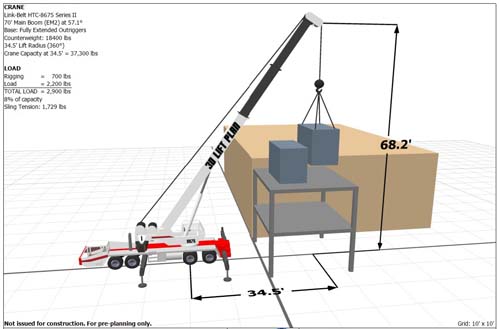
In other words, the tipping moment should be at least 1.25 times the stabilizing load moment. In accordance with the European standards (EN 13000) the maximum load in a capacity chart is based on 80 percent of the tipping load plus 10 percent of the boom mass. The capacity of a mobile crane is, among other things, based on the tipping moment. It is defined in tons/meters and for ringer cranes, the center of the ring is considered as the basis for the radius.

The weight of the load will not change during the lift and, from the starting point until the set-down position, radius and hook height need to be considered.Ī key element here is the required load moment of the crane, which is the load (ton/tons) x radius (m) measured to the center of the slewing crane. In this document, all the configurations are listed with the corresponding capacity charts, the relevant details and its limitations.

To judge which configuration should be used, the manufacturer’s instruction manual and capacity chart should be consulted. After taking into account site conditions, it is time to focus on the crane and its configuration. If there is any doubt, the load should be weighed to obtain the accurate data. Nothing should be assumed when preparing for a lift all the information needs to be accurate and up to date. Focusing on the loadīut, preparing for a lift using a mobile crane should start by focusing on the load itself: the weight, center of gravity, dimensions, lifting points, and other information provided by the manufacturer of the load. They are very complex machines with a lot of different components that can be used in numerous configurations, to fit the proposed lifting job.


Mobile cranes, according to European directives, are designed, built and operated in accordance with a comprehensive package of standards and safety legislation. Have you ever opened a newspaper and seen an article about an accident involving a mobile crane on a construction site? In some cases, these incidents can result in serious injuries for workers and a large amount of damage.Ī recent article spotted in a local newspaper said that an investigation into an accident found the main causes to be the crane’s lack of stability and weak ground-bearing capacity.īut why do we see so many accidents happening with mobile cranes? Are operators under-estimating external factors that impact on a crane’s functionality? Or, are they ignoring the manufacturer’s instructions and safety regulations and applying too much pressure on the machines? Ton Raemakers, senior consultant, discusses some of the first steps that operators should take to prepare for a critical lift. Over the past 40 years, Eager.one has built up a great deal of experience and knowledge within the world of heavy lift and specialized transport, which it has translated into a series of master classes on how to execute a safe and well-prepared project.


 0 kommentar(er)
0 kommentar(er)
